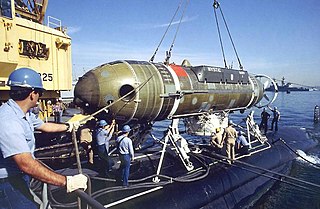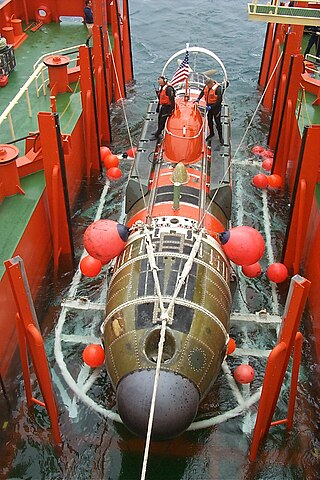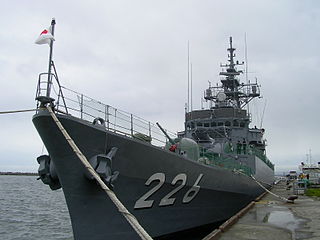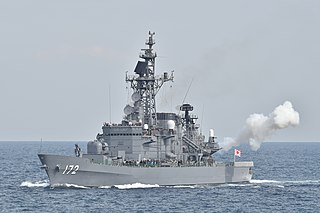
Mystic class is a class of Deep-Submergence Rescue Vehicles (DSRVs), designed for rescue operations on submerged, disabled submarines of the United States Navy or foreign navies. The two submarines of the class were never used for this purpose, and were replaced by the Submarine Rescue Diving Recompression System.

A deep-submergence vehicle (DSV) is a deep-diving crewed submersible that is self-propelled. Several navies operate vehicles that can be accurately described as DSVs. DSVs are commonly divided into two types: research DSVs, which are used for exploration and surveying, and DSRVs, which are intended to be used for rescuing the crew of a sunken navy submarine, clandestine (espionage) missions, or both. DSRVs are equipped with docking chambers to allow personnel ingress and egress via a manhole.

The Japan Maritime Self-Defense Force, abbreviated JMSDF, also simply known as the Japanese Navy, is the maritime warfare branch of the Japan Self-Defense Forces, tasked with the naval defense of Japan. The JMSDF was formed following the dissolution of the Imperial Japanese Navy (IJN) after World War II. The JMSDF has a fleet of 154 ships, 346 aircraft and 50,800 personnel.

A deep-submergence rescue vehicle (DSRV) is a type of deep-submergence vehicle used for rescue of downed submarines and clandestine missions. While DSRV is the term most often used by the United States Navy, other nations have different designations for their vehicles.

DSRV-2Avalon was a Mystic-class deep-submergence rescue vehicle rated to dive up to 5,000 feet (1,500 m) to rescue submarine crews trapped deep under the sea. The submarine was acquired in response to the loss of the USS Thresher, so that the Navy would have a way to rescue trapped submarine crews.

DSRV-1Mystic is a deep-submergence rescue vehicle that is rated to dive up to 5,000 feet. It was built by Lockheed for the US Navy at a construction cost of $41 million and launched 24 January 1970. It was declared fully operational in 1977 and named Mystic.

The third USS Pigeon (ASR–21) was the lead ship of her class of submarine rescue ships. Laid down on 17 July 1968 by the Alabama Dry Dock and Shipbuilding Co., Mobile, Alabama, the ship was launched on 13 August 1969, sponsored by Mrs. Allen M. Shinn, wife of Vice Admiral Shinn, Commander Naval Air Force, U.S. Pacific Fleet, and commissioned on 28 April 1973. She was a sister ship to USS Ortolan (ASR-22).

JS Ishikari (DE-226) was the first destroyer escort with a gas turbine engine and surface-to-surface missiles of the Japanese Maritime Self-Defense Force. She is the successor of the earlier Chikugo class. Entering service in 1981, she remained active until 2007 when she was decommissioned.
The Type 925 Dajiang with NATO reporting name Dajiang, or 大江 in Chinese, meaning Great River, is a type of naval auxiliary ship belonging to the People's Republic of China. Each ship is usually equipped with up to two Type 7103 DSRV class Deep Submergence Rescue Vehicles (DSRVs). The ship is designed to replace the first People's Liberation Army Navy (PLAN) submarine tender PLANS Mount Tai, and the lead ship of the Dajiang class is the Changxingdao. The Type 925 is a submarine tender that can also be used as a submarine rescue ship, and hence, it is designated as a submarine support ship by Chinese.

A submarine rescue ship is a surface support ship for submarine rescue and deep-sea salvage operations. Methods employed include the McCann Rescue Chamber, deep-submergence rescue vehicles (DSRV's) and diving operations.

The Cheonghaejin class is a submarine rescue ship class of the Republic of Korea Navy. Only one ship has been built in the class, ROKS Cheonghaejin, in 1995. Its operations include rescuing trapped sailors in submarines, naval operation support for submarines, underwater research and mapping support, and recovery of sunk vessels. It is equipped with a deep submergence rescue vehicle (DSRV) that operates up to 500 metres (1,600 ft), and a rescue chamber that holds up to nine people.

JS Yamayuki (DD-129/TV-3519) was a Hatsuyuki-class destroyer of the Japan Maritime Self-Defense Force (JMSDF).
Five naval vessels of Japan have been named Chiyoda:

JS Shimakaze (DDG-172/TV-3521) is the second ship of the Hatakaze-class guided missile destroyers built for the Japan Maritime Self-Defense Force (JMSDF). The ship was reclassified as training ship in 2021.

JS Samidare (DD-106) is the sixth Murasame-class destroyer of the Japan Maritime Self-Defense Force (JMSDF). She was commissioned on 21 March 2000.

JS Chihaya (ASR-403) is a submarine rescue ship of Japan Maritime Self-Defense Force.

JS Chiyoda (ASR-404) is a submarine rescue ship of Japan Maritime Self-Defense Force.

JDS Chihaya (ASR-401) was a submarine rescue ship of Japan Maritime Self-Defense Force.

JS Setoyuki (DD-131/TV-3518) was a Hatsuyuki-class destroyer of the Japanese Maritime Self-Defense Force.
Submarine rescue is the process of locating a sunk submarine with survivors on board, and bringing the survivors to safety. This may be done by recovering the vessel to the surface first, or by transferring the trapped personnel to a rescue bell or deep-submergence rescue vehicle to bring them to the surface. Submarine rescue may be done at pressures between ambient at depth, and sea level atmospheric pressure, depending on the condition of the distressed vessel and the equipment used for the rescue. Self-rescue of submarine personnel by buoyant free ascent at ambient pressure is considered submarine escape. Survivors may require recompression treatment for decompression illness.















